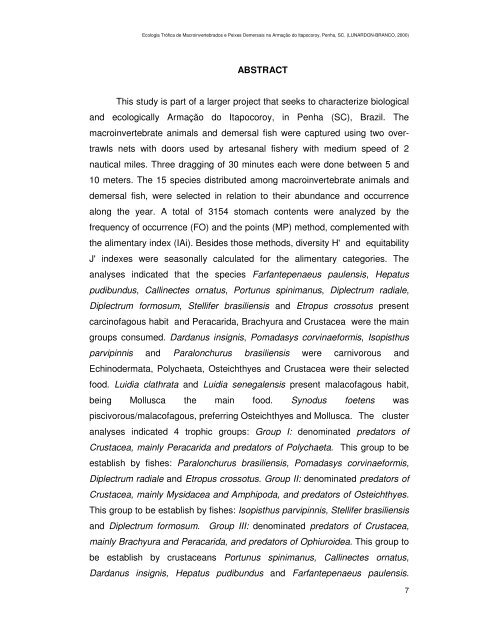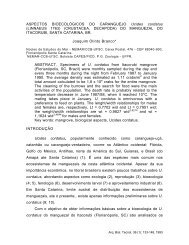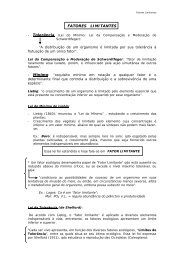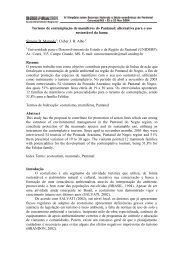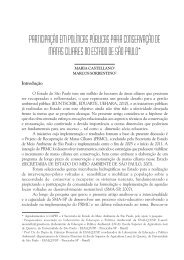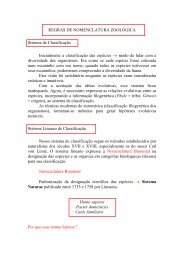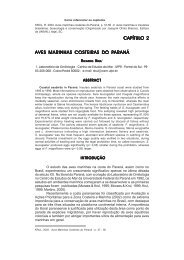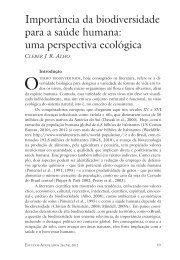texto completo - Projeto Aves Marinhas
texto completo - Projeto Aves Marinhas
texto completo - Projeto Aves Marinhas
You also want an ePaper? Increase the reach of your titles
YUMPU automatically turns print PDFs into web optimized ePapers that Google loves.
Ecologia Trófica de Macroinvertebrados e Peixes Demersais na Armação do Itapocoroy, Penha, SC. (LUNARDON-BRANCO, 2000)<br />
ABSTRACT<br />
This study is part of a larger project that seeks to characterize biological<br />
and ecologically Armação do Itapocoroy, in Penha (SC), Brazil. The<br />
macroinvertebrate animals and demersal fish were captured using two over-<br />
trawls nets with doors used by artesanal fishery with medium speed of 2<br />
nautical miles. Three dragging of 30 minutes each were done between 5 and<br />
10 meters. The 15 species distributed among macroinvertebrate animals and<br />
demersal fish, were selected in relation to their abundance and occurrence<br />
along the year. A total of 3154 stomach contents were analyzed by the<br />
frequency of occurrence (FO) and the points (MP) method, complemented with<br />
the alimentary index (IAi). Besides those methods, diversity H' and equitability<br />
J' indexes were seasonally calculated for the alimentary categories. The<br />
analyses indicated that the species Farfantepenaeus paulensis, Hepatus<br />
pudibundus, Callinectes ornatus, Portunus spinimanus, Diplectrum radiale,<br />
Diplectrum formosum, Stellifer brasiliensis and Etropus crossotus present<br />
carcinofagous habit and Peracarida, Brachyura and Crustacea were the main<br />
groups consumed. Dardanus insignis, Pomadasys corvinaeformis, Isopisthus<br />
parvipinnis and Paralonchurus brasiliensis were carnivorous and<br />
Echinodermata, Polychaeta, Osteichthyes and Crustacea were their selected<br />
food. Luidia clathrata and Luidia senegalensis present malacofagous habit,<br />
being Mollusca the main food. Synodus foetens was<br />
piscivorous/malacofagous, preferring Osteichthyes and Mollusca. The cluster<br />
analyses indicated 4 trophic groups: Group I: denominated predators of<br />
Crustacea, mainly Peracarida and predators of Polychaeta. This group to be<br />
establish by fishes: Paralonchurus brasiliensis, Pomadasys corvinaeformis,<br />
Diplectrum radiale and Etropus crossotus. Group II: denominated predators of<br />
Crustacea, mainly Mysidacea and Amphipoda, and predators of Osteichthyes.<br />
This group to be establish by fishes: Isopisthus parvipinnis, Stellifer brasiliensis<br />
and Diplectrum formosum. Group III: denominated predators of Crustacea,<br />
mainly Brachyura and Peracarida, and predators of Ophiuroidea. This group to<br />
be establish by crustaceans Portunus spinimanus, Callinectes ornatus,<br />
Dardanus insignis, Hepatus pudibundus and Farfantepenaeus paulensis.<br />
7


